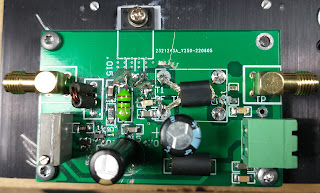After letting the smoke out of yet more transistors I finally managed to get a repeatable 6W out of the amplifier. I made two changes to the amplifier:
- The output transformer was changed to a larger binocular core, and
- The input transformer was changed to a 9:1 transformer instead of a 4:1 transformer.
The first change appears to have resolved the issue where a few amps was reducing the return loss. See the post here for what was happening.
After popping yet another transistor I suspected the voltage across the base with the 4:1 transformer was exceeding the Vbe rating of the transistor with fatal results. With the new transformer I have yet to pop the transistor.
However, I still can't achieve a continuous 10W because the transistor, which I believe is rated for 17W, starts shutting down as the junction temperature rises. I have a large finned heatsink so the cause of this is unknown at present.
Note that I am measuring power using a single RF frequency, or carrier. Thus the 6W is equal to average power. This gives me hope that with a two tone test signal 12W PEP is possible.
Why the modest label? My goal was to achieve 10W PEP with a general purpose transistor. I had to use a RF transistor and at present I haven't measured 10W PEP though I believe the amplifier can achieve this with a two-tone test signal.
The best of the general purpose transistors available today that I tested was a 2SC6144 which achieved 4W with a single frequency on 80m. However, this was with the smaller output transformer so the full potential of this device has not been tested. If you try one please let me know what you achieved.
There are some obsolete transistors mentioned here that also delivered 4W continuous which shows the junk box can be a useful source.
73's
Richard







